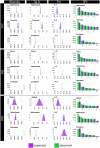Demographic History of the Human Commensal Drosophila melanogaster
- PMID: 30715331
- PMCID: PMC6430986
- DOI: 10.1093/gbe/evz022
Demographic History of the Human Commensal Drosophila melanogaster
Erratum in
-
Corrigendum to: Demographic history of the human commensal Drosophila melanogaster.Genome Biol Evol. 2021 Mar 1;13(3):evab046. doi: 10.1093/gbe/evab046. Genome Biol Evol. 2021. PMID: 33763690 Free PMC article. No abstract available.
Abstract
The cohabitation of Drosophila melanogaster with humans is nearly ubiquitous. Though it has been well established that this fly species originated in sub-Saharan Africa, and only recently has spread globally, many details of its swift expansion remain unclear. Elucidating the demographic history of D. melanogaster provides a unique opportunity to investigate how human movement might have impacted patterns of genetic diversity in a commensal species, as well as providing neutral null models for studies aimed at identifying genomic signatures of local adaptation. Here, we use whole-genome data from five populations (Africa, North America, Europe, Central Asia, and the South Pacific) to carry out demographic inferences, with particular attention to the inclusion of migration and admixture. We demonstrate the importance of these parameters for model fitting and show that how previous estimates of divergence times are likely to be significantly underestimated as a result of not including them. Finally, we discuss how human movement along early shipping routes might have shaped the present-day population structure of D. melanogaster.
Keywords: Drosophila; admixture; demography; migration; population expansion.
© The Author(s) 2019. Published by Oxford University Press on behalf of the Society for Molecular Biology and Evolution.
Figures




References
-
- Baudry E, Viginier B, Veuille M.. 2004. Non-African populations of Drosophila melanogaster have a unique origin. Mol Biol Evol. 21(8):1482–1491. - PubMed
-
- Begun D, Aquadro C.. 1993. African and North American populations of Drosophila are very different at the DNA level. Nature 365(6446):548–550. - PubMed
Publication types
MeSH terms
Grants and funding
LinkOut - more resources
Full Text Sources
Molecular Biology Databases

